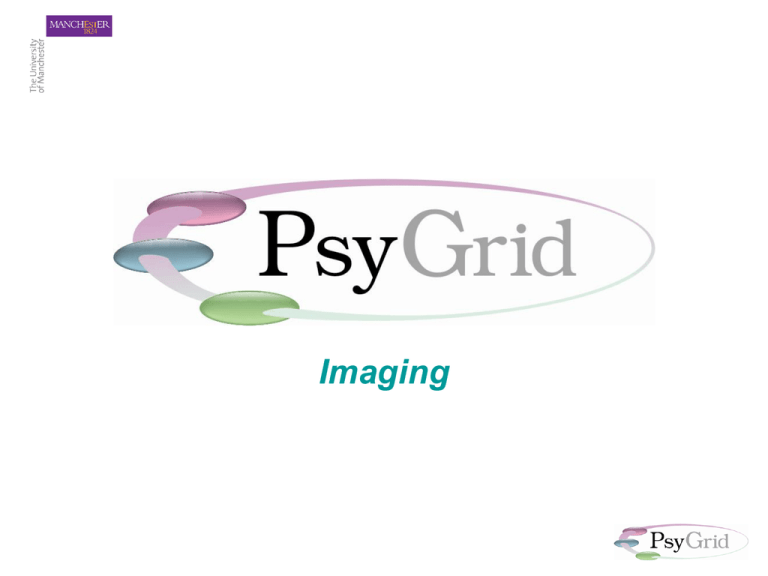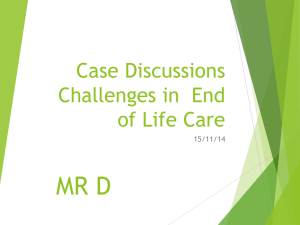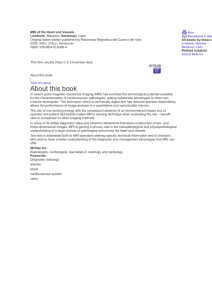Imaging
advertisement

Imaging Why is psychosis tractable now? • Late 1990’s – epidemiological discontinuities emerging – new environmental risk factors identified • 2000-3 – extended phenotype characterised • 2002-5 – first susceptibility genes identified • 2004-5 – first gene-environment interactions shown at population and individual level What questions can a big cohort address? • Role of small risk factors • Specificity of prodromes • Rare subtypes: – early onset – ethnic subgroups • Adverse outcomes: – – – – recovery versus chronicity suicide Forensic treatment complications i.e. prevention and personalised prevention What is PsyGrid? • e-Science project funded by the MRC, and the Department of Health • Aim 1 (Technological): Develop applications and middleware to support studies, clinical trials and diagnosis in mental health (Team of 5 software developers) • Aim 2 (Clinical): Use outputs of ‘Aim 1’ to perform longitudinal study of schizophrenics from First Episode Psychosis over 2 years and study epidemiology of schizophrenia (Team of 8 research nurses) Initiation: May 2005 PsyGrid so far… Electronic Data collection starts Mental Health Research Network adopts PsyGrid as core technology platform April ‘06 May ‘06 Mental Health Clinical Trials (Manchester) adopts PsyGrid platform July ‘06 SCAG approval given to link NHS Mental Health Minimum Data Set Sept ‘06 Project end: May 2008 National EDEN early intervention study uses PsyGrid Nov ‘06 EDIE 2: clinical trial starts on PsyGrid Incremental development from the core E-Epidemiology Workbench Diagnosis and prognosis Data Collection Core Clinical Trials Platform Y-BAR: young brains at risk Left-sided change over 12 months with new onsets in association with SANE ales Establish Grid-based image analysis methodology Females 0.3 Thalamo-cortical topography – for normative database of brain development during at risk years for psychosis – merge Grid-based clinical, genetic and risk factor data average asymmetry in grey matter Volumetric slice profiles of average asymmetry in white matter Volumetric slice profiles of a onto brain development to for peak height corrected for peak corrected 9.24 height identify signatures of onset and chronicity 0.2 0.1 241.00 225.00 209.00 193.00 177.00 161.00 -0.1 145.00 129.00 113.00 0 -0.2 -0.3 -0.4 Planum temporale -0.5 -10 -15 Talairach y coordinate (m m ) 0.12 0.1 -37.50 0.02 -50.00 0.04 -62.50 0.06 -75.00 -6.45 0.08 -87.50 t-statistic 75.00 62.50 50.00 37.50 Leftward planum asymmetry 6.45 -100.00 -8.09 25.00 -9.24 -5 12.50 0.00 -12.50 -25.00 -37.50 -50.00 -62.50 -75.00 -87.50 -100.00 Bullmore, Roberts, Smith, Taylor, Crow, Deakin -10 -10 -15 -15 y coordinate (m m m )) y coordinate (m 8.09 0 -112.50 t-statistic 75.00 75.00 62.50 62.50 -5 -5 50.00 50.00 0 0 37.50 37.50 5 25.00 25.00 5 5 12.50 12.50 10 0.00 0.00 10 10 -12.50 -12.50 15 -25.00 -25.00 y coordinate (m m ) 15 15 Asymmetry (cm^3) -112.50 0.14 0 -0.02 Talairach Early Detection Workflow Patient referred by clinician Retrieve baseline scans Submit scans for morphometric analysis to PsyGrid analysis If longitudinal changes detected Baseline Structural MRI Scan Store on PsyGrid 12 Month followup structural MRI Scan Store on PsyGrid Retrieve demographically matched non-psychotic patient data Retrieve demographically matched psychotic patient data with medium term outcome data Compare with patient diagnostic indicator Compare with patient - prognosis indicator and treatment guide Feedback diagnostic and prognosis indicators to clinician Infrastructure Needed • Large scale distributed image storage with fast access • 3 data sets – Active patient data – Non-psychotic normative data – Psychotic normative data • High throughput image analysis capability • Computationally intensive longitudinal morphometric analysis • Security (clinical patient data) • The MRI and ancillary data on individual patients, and the diagnostic and prognostic reports issued as a result of their analysis, will be highly sensitive and mandate the enhanced data security enabled by the grid. Infrastructure objectives • Design and implement Grid infrastructure to support submission of images and retrieval of results from Manchester, Oxford, Edinburgh and London • Design and implementation of a modular image processing pipeline for optimal, standardized analysis of longitudinal brain changes in structural MRI data. • Design and implementation of databases that can i) hold large quantities of MRI data derived morphometric variables and ancillary (e.g. clinical, cognitive and genetic) data; and ii) support interactive interrogation of MRI databases as a basis for probabilistic diagnosis and prognosis of index patient data. Neuroscience objectives • Standard MR image acquisition and quality control protocols • Reliability study to achieve harmonisation between scanners at the four participating centres • Acquire longitudinal data on a cohort of 20 patients with a first episode of psychosis, each scanned twice on a 12 month interval





